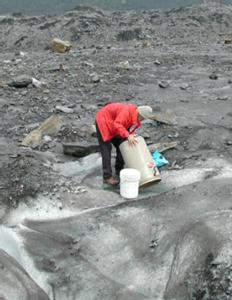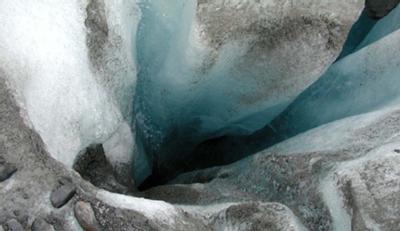8 July, 2000
July 8, 2000
Matanuska Glacier, Alaska
It seems glaciers aren’t the only things that advance and retreat! Today
we experienced mixed results in the progress in our project. Through the
efforts of Justin, Josh and Ben Cashman we finally had a working ISCO at
our disposal. Earlier in the week one had gotten pulled into the water
and needed a good drying out. They managed to get it back into good
working condition.
The vent that we decided to monitor first is one we call Trail Vent as
it surfaces very close to a trail that hikers can take out onto the
glacier. It is a very new vent. In fact it just opened up a couple of
days ago. New vents can form from year to year and old ones can plug up
and stop flowing. The same is true of moulins. After much discussion we
decided our best strategy would be to try to establish connections
between the closest moulin/vent pair. This parcticular vent is best
suited for this approach.
After getting the ISCO set up we hauled 160 pounds of rock salt, a
plastic barrel and a couple of five gallon buckets out to the nearest
moulin, maybe a quarter mile or so up the glacier. After looking it over
we decided to go to one just a little farther away as it looked like the
better of the two to work with. We decided to use a lot of salt
initially since we weren’t sure how much it might get diluted before
exiting through a vent. Our first hope is that it actually exits the
vent we’re monitoring. We took a barrel along to see how much salt we
could get dissolved and in solution quickly. As I suspected we could not
get even a 40 pound bag to completely dissolve in the cold water. So we
ended up dumping the barrel and three dry bags of salt into the moulin.
We hope that the turbulent flow inside the moulin and glacier conduit
system will dissolve it all quickly.
We had arranged to be picked up at two o’clock and since we had finished
early decided to have a look around. As we walked away and past the
first moulin we began to talk about what we thought could be happening
underneath. What we noticed as we looked around was that a series of
four or five moulins seemed to line up somewhat in a low valley of ice
that ran east-west. We also saw that cracks in the ice ran north-south.
Could it be possible that the moulins were forming in the cracks and
then expanding them to run to the North or South Vents? If so we would
be monitoring the wrong vent! In southern Indiana where I went to
college limestone is dissolved away by water to form caves. I seemed to
recall (correctly or not) that water running off the land would go into
cracks in the limestone and slowly dissolve it to form sinkholes and
caves. I asked Ben if sinkholes line up along valleys the way we were
seeing the moulins line up in this ice valley. It seemed to me that the
same forces and actions should be taking place here. From what he
recalls he believes that they do. If so then maybe our moulin will drain
toward our Trail Vent! We hope to find out soon. If we see nothing in
our samples did the water flow out some other vent? Will the salt be so
diluted by the time it exits that it fails to show significant increases
in conductivity? Fortunately for us there are ISCOs scattered around at
many of the vents. If it comes out in detectable amounts then we will
find our connection. If nothing shows up anywhere we may need to
increase the salt. At Trail Vent we decided to sample at 15 minute
intervals. At the other vents samples are only taken every two hours.
We’re hopeful that something will show up somewhere. If not then we’ll
have to rethink our strategy.
In spite of getting a good start on this part of the research we
encountered problems in the afternoon with the fluorometer. Before
leaving for Alaska I had prepared a set of standard dye solutions. These
are solutions that are mixed with known concentrations of dye. The
fluorometer does not seem to want to give consistently accurate readings
of the concentrations of these standards. After many attempts to remedy
the situation we decided to gather as much information as possible and
call the technical support crew at the manufacturer next week. I had
experienced similar problems when working with the fluorometer at home
and found the tech support person to be very helpful. So we will be on
the phone addressing this issue first thing Monday morning. Tomorrow we
will see how fruitful today’s work was. Till then.....
Marvin Giesting

Deploying the ISCO water sampler at Trail Vent.

Ben is dumping the predissolved salt into the moulin. All around it looks as though we can't possibly be on a glacier. There is just a thin layer of rock debris on top of the ice. It is only like this near the terminus. Higher up the glacier the ice is visible everywhere except on the moraines. You can see that rocks and silt near the moulin have been washed into it by running water in the past.

Looking down into the small moulin we worked with today.

This is an old inactive moulin we discovered on our way back from dumping the salt. The sides are grey from all the silt that keeps rinsing down from above as the ice melts away.
Contact the TEA in the field at
.
If you cannot connect through your browser, copy the
TEA's e-mail address in the "To:" line of
your favorite e-mail package.
|
